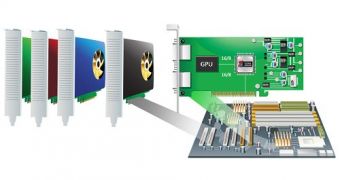Some end-users may be aware of the existence of the HydraLogix engine, a solution that allow for multiple graphics cards to be used in multi-GPU setups, regardless of vendor and model, and its maker, LucidLogix has just release the UNITY architecture, which allows the engine to be implemented directly into the video cards themselves.
So far, the hydra engine has been used in several motherboards under the form of the Hydra 200 SoC (system-on-chip).
Thus, there are very few options for enthusiasts when trying to design a system capable of unrestricted multi-GPU configurations.
In order to expand the use of its HydraLogix engine, LucidLogix has now revealed the existence of the aptly named UNITY video card architecture.
Basically, this architecture enables hardware makers to develop video controllers that integrate the aforementioned HydraLogix 200 processor.
What this means is that a card featuring this chip will be able to combine its might with that of another one, regardless of model or manufacturer.
In other words, GeForce and Radeon cards from NVIDIA and AMD, respectively, will be able to work as one even on platforms that don't natively support this feature.
According to the press release, such multi-GPU configurations can boost graphics performance by up to 40-80%.
“The UNITY architecture provides a win-win situation for the market and for consumers,” said Offir Remez, Lucid President.
“Graphics board vendors can increase the total market for multi-GPU computing from the low end to the high end. And as a consumer, why wouldn’t you choose to buy a graphics card with HYDRALOGIX on board? You only get more!”, he says.
The architecture is already available to OEMs and actual products are expected to start shipping around the holidays, for prices of under $199.
“The market for multi-GPU systems has shown continual growth even in a down economy,” said Jon Peddie of Jon Peddie Research.
“Lucid’s expansion of its HYDRALOGIX technology to the graphics board further expands options for OEMs, ODMs and consumers, and should provide additional momentum to the growth of reasonably priced, high-powered gaming systems,” he added.

 14 DAY TRIAL //
14 DAY TRIAL //